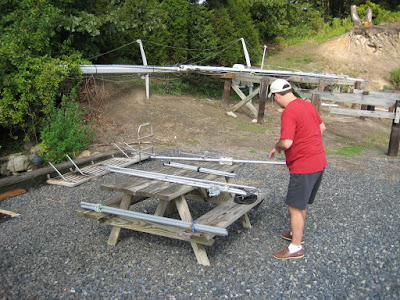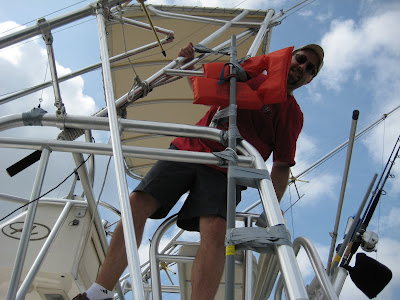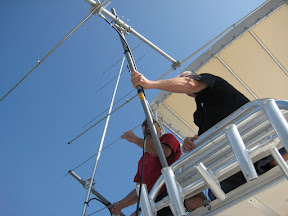This is part 2 of this series. In case you missed part 1, it's available here.
 After arriving at the marina, the first orders of business were to transfer the equipment from the truck to the boat, then to assemble the 6m and 2m beams. The plan was the assemble the beams on land, secure the first of three five-foot mast mast sections to the upper bridge of the boat, then raise the antennas once we were past the couple of low bridges that we had to pass on the way out to the open sea.This worked out well, and even with relatively calm seas, it was a lot easier to assemble the antennas on land. (Besides, while dropping a nut or a screw onto the gravel on land would be difficult to find, it would be a lot easier than jumping overboard should the same happen while at sea!) We finished assembling the antennas, took them down to the boat, and figured out a way to secure them for the two-hour trip from the marina to the closest part of FM39.
After arriving at the marina, the first orders of business were to transfer the equipment from the truck to the boat, then to assemble the 6m and 2m beams. The plan was the assemble the beams on land, secure the first of three five-foot mast mast sections to the upper bridge of the boat, then raise the antennas once we were past the couple of low bridges that we had to pass on the way out to the open sea.This worked out well, and even with relatively calm seas, it was a lot easier to assemble the antennas on land. (Besides, while dropping a nut or a screw onto the gravel on land would be difficult to find, it would be a lot easier than jumping overboard should the same happen while at sea!) We finished assembling the antennas, took them down to the boat, and figured out a way to secure them for the two-hour trip from the marina to the closest part of FM39.
 Securing the first five-foot mast section to the upper bridge turned out to be a bit more difficult than we anticipated. The issue was that we needed to have that base section as close to vertical as possible while making sure that it was very secure. We'd tighten it up with some U-bolts to the railings, but that would tilt it in one direction or another. Finally, using a combination of U-bolts, duct tape, and a life preserver (as a spacer), we got the base mast section attached where we wanted it, and we were ready to leave port. Fortunately, Captain Karl, who is a very experienced fisherman, had plenty of time to go to the store for provisions while Matthew and I were assembling things. Going hungry was not going to be an issue on this trip!
Now that the mast was secured and the antennas were stowed, it was time to leave the slip to head out to the ocean. After a stop for fuel, we headed out along Cheesequake Creek past a couple of bridges and were soon in Raritan Bay heading for the open ocean. Karl opened up the twin diesels and we were on our way down to FM39, a trip that would take just about 2 hours running at about 25 knots. By this time, the weather had cleared up completely, the sun was out, and the seas were almost dead calm, with occasional one to two foot gentle swells.
During the trip out, we discussed how we'd operate, with the main concern being keeping the antennas pointed where we wanted them to point. Initially we thought we might set up the antennas and radios, and then move slowly through the water to keep things pointing in a constant direction. However, Karl came up with what turned out to be a better suggestion: We'd anchor and since there wasn't a lot of wind, the prevaling currents would keep us pointed in a constant direction. That's what we wound up doing, and it worked out quite well.
Securing the first five-foot mast section to the upper bridge turned out to be a bit more difficult than we anticipated. The issue was that we needed to have that base section as close to vertical as possible while making sure that it was very secure. We'd tighten it up with some U-bolts to the railings, but that would tilt it in one direction or another. Finally, using a combination of U-bolts, duct tape, and a life preserver (as a spacer), we got the base mast section attached where we wanted it, and we were ready to leave port. Fortunately, Captain Karl, who is a very experienced fisherman, had plenty of time to go to the store for provisions while Matthew and I were assembling things. Going hungry was not going to be an issue on this trip!
Now that the mast was secured and the antennas were stowed, it was time to leave the slip to head out to the ocean. After a stop for fuel, we headed out along Cheesequake Creek past a couple of bridges and were soon in Raritan Bay heading for the open ocean. Karl opened up the twin diesels and we were on our way down to FM39, a trip that would take just about 2 hours running at about 25 knots. By this time, the weather had cleared up completely, the sun was out, and the seas were almost dead calm, with occasional one to two foot gentle swells.
During the trip out, we discussed how we'd operate, with the main concern being keeping the antennas pointed where we wanted them to point. Initially we thought we might set up the antennas and radios, and then move slowly through the water to keep things pointing in a constant direction. However, Karl came up with what turned out to be a better suggestion: We'd anchor and since there wasn't a lot of wind, the prevaling currents would keep us pointed in a constant direction. That's what we wound up doing, and it worked out quite well.
 We got on station at about 2PM local time, a bit later than planned, and started working on getting the antennas mounted. We decided to travel into the grid a bit (the closest point would have been FM39ax) because we wanted room to manuever, so you can see from the photo that we were actually in FM39aw. (By the way, no, the bridge of the boat was not at 96 feet; that's my old GPS and while it's dead-on horizontally, it seems to have a few issues with altitude. I know that's not terribly unusual, but figured I'd mention it.)
Matthew and I started attaching the antennas to the mast sections. We put each
We got on station at about 2PM local time, a bit later than planned, and started working on getting the antennas mounted. We decided to travel into the grid a bit (the closest point would have been FM39ax) because we wanted room to manuever, so you can see from the photo that we were actually in FM39aw. (By the way, no, the bridge of the boat was not at 96 feet; that's my old GPS and while it's dead-on horizontally, it seems to have a few issues with altitude. I know that's not terribly unusual, but figured I'd mention it.)
Matthew and I started attaching the antennas to the mast sections. We put each  antenna on one of the two remaining mast sections, with the plan being to mount the 6m three-element beam on top, and the 2m nine-element beam about five feet below it. With the seas being very calm, it was easy to do that part of the work, but getting the mast sections into the base section turned out to be quite a challenge. Although Captain Karl had moved the outriggers out of
antenna on one of the two remaining mast sections, with the plan being to mount the 6m three-element beam on top, and the 2m nine-element beam about five feet below it. With the seas being very calm, it was easy to do that part of the work, but getting the mast sections into the base section turned out to be quite a challenge. Although Captain Karl had moved the outriggers out of  the way, there were still a lot of things that we had to move the antennas around to get it mounted. Matthew and Captain Karl worked to get the mast sections (with antennas) set up, while I handled the feed line and checked to make sure that the mast remained vertical and that the antennas remained aligned. It was important to make sure they were pointed in the same direction, since we'd have no way to turn them independently. As it turns out, they seemed to have a mind of their own.
To be continued ...
the way, there were still a lot of things that we had to move the antennas around to get it mounted. Matthew and Captain Karl worked to get the mast sections (with antennas) set up, while I handled the feed line and checked to make sure that the mast remained vertical and that the antennas remained aligned. It was important to make sure they were pointed in the same direction, since we'd have no way to turn them independently. As it turns out, they seemed to have a mind of their own.
To be continued ...
No comments:
Post a Comment